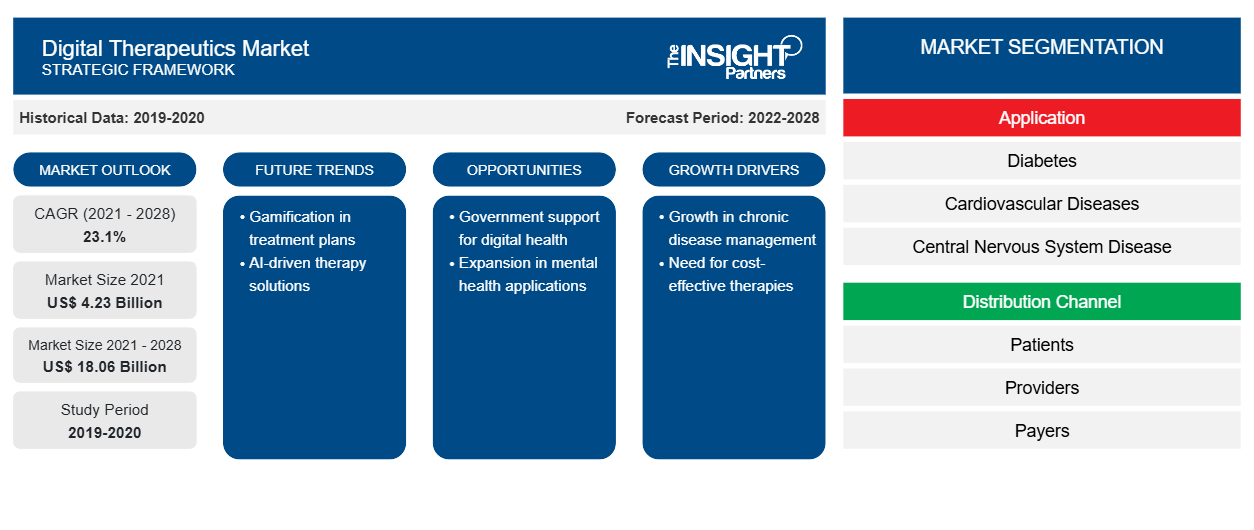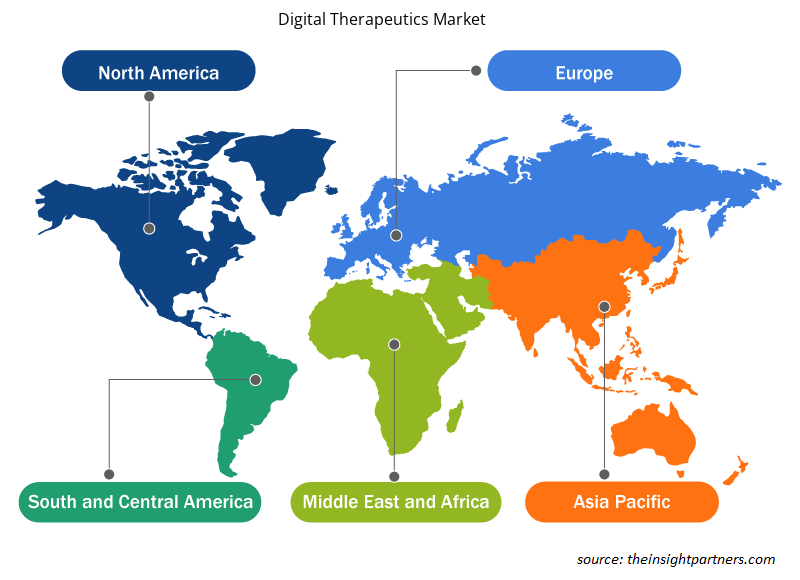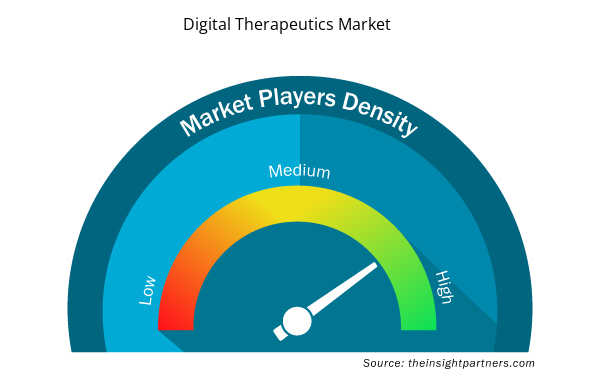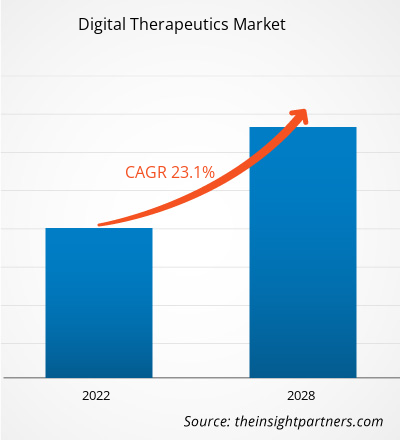[Research Report] The digital therapeutics market size was valued at US$ 4,226.94 million in 2021 and is projected to reach US$ 18,061.79 million by 2028; it is estimated to register a CAGR of 23.1% from 2022 to 2028.
Analyst’s ViewPoint
The market is likely to be driven by rising smartphone prevalence in developed and emerging nations, the cost-effectiveness of digital health technology for providers and patients, and rising demand for integrated healthcare systems and patient-centric treatment. According to Kepios, there will be 4.27 billion internet users worldwide in April 2021, accounting for more than 60% of the global population. As this number increases, awareness about smart health tracking is expected to improve. Consumers in developed economies are becoming more aware of innovative medical items for treatment of medical disorders. According to the Organisation for Economic Cooperation and Development, healthcare spending as a proportion of GDP climbed significantly in 2020, as the economic condition in several OECD nations worsened and health spending increased. As a result, the preference has shifted towards advanced medical services, including the increased demand for advanced therapeutic devices. Product acceptance is another aspect driving market expansion.
Market Overview
Digital therapeutics provide evidence-based therapeutic intrusions to patients that focus on the treatment of diseases with programs, and management using high-quality software. Digital therapeutics have made progress in the last few years, harnessing technology the supplement or potentially replace traditional clinical therapy. They are used independently or in concert with devices, medications, or other therapies for the optimization of patient care and health outcomes. The key factors contributing to the growth of the digital therapeutics market is the rising prevalence of chronic diseases, concerns regarding the need to reduce healthcare costs, and partnerships and collaborations by companies. However, the growth of the market is hindered by the cyber threat and rise in data security, which limits its potential applications in the medical field.
Customize This Report To Suit Your Requirement
You will get customization on any report - free of charge - including parts of this report, or country-level analysis, Excel Data pack, as well as avail great offers and discounts for start-ups & universities
Digital Therapeutics Market: Strategic Insights

- Get Top Key Market Trends of this report.This FREE sample will include data analysis, ranging from market trends to estimates and forecasts.
Customize This Report To Suit Your Requirement
You will get customization on any report - free of charge - including parts of this report, or country-level analysis, Excel Data pack, as well as avail great offers and discounts for start-ups & universities
Digital Therapeutics Market: Strategic Insights

- Get Top Key Market Trends of this report.This FREE sample will include data analysis, ranging from market trends to estimates and forecasts.
Market Driver
Rising Prevalence of Chronic Diseases to Drive the Digital Therapeutics Market Growth
Chronic diseases, including heart disease, stroke, diabetes, and obesity, account for most of the healthcare costs of any country. According to a report by the World Health Organization (WHO), 463 million adults in the world had diabetes in 2020, and the number is expected to rise to 629 million by 2045. Asia Pacific, Europe, and the Middle East and Africa report a high prevalence of diabetes. The disease is mainly characterized by the inadequate regulation of blood glucose levels due to the body’s inability to produce or effectively utilize the hormone insulin, and has no specialized cure. According to the IDF Diabetes Atlas 2021, published by the International Diabetes Federation, North America reported ~51 million people living with diabetes by 2021, and the number is expected to reach 63 million by 2045. In addition, Southeast Asia records ~16.8% of the global population of diabetic people. By 2035, ~130 million adults in the US population are projected to suffer from some form of CVDs.
The obesity rates are increasing rapidly in developed and developing economies in the world due to sedentary and unhealthy lifestyles. As per data published by the Organization for Economic Co-operation (OECD) in 2017, ~19.5% of the adult population was obese in OECD area. This rate is less than 6% in Korea and Japan, and more than 30% in Hungary, New Zealand, Mexico, and the US. Moreover, the prevalence has increased rapidly in Australia, Canada, Chile, South Africa, and the UK in the last decade, with ~25% or more adults being obese. Obesity levels are anticipated to reach ~47%, ~39%, and ~35% in the US, Mexico, and England, respectively, by 2030.
In order to enhance chronic disease management and offer more treatment options to patients, digital therapeutics help to deliver evidence-based therapeutic solutions. It enable patients to better control their care and provides potential solutions for chronic diseases management, such as diabetes. Hence, the rise in the prevalence of chronic diseases is driving the digital therapeutics market.
Segmental Analysis
Application-Based Insights
Based on application, the digital therapeutics market is segmented into respiratory diseases, central nervous system diseases, smoking cessation, musculoskeletal disease, cardiovascular diseases, diabetes, and other applications. In 2021, the diabetes segment held the largest digital therapeutics market share and the same segment is anticipated to register the highest CAGR of in the market during the forecast period due to increasing incidences of diabetes across the globe, high prevalence of obesity in developing countries, and significant risks and economic costs associated with obesity-related diseases.
Diabetes is a life-threatening chronic disease with no specialized cure. It is mainly caused by the body’s inability to produce or effectively utilize the hormone insulin. This inability prevents the body from adequately regulating blood glucose levels. There are two types of diabetes namely diabetes type-I also known as diabetes insipidus and diabetes type-II also termed as diabetes mellitus. Incidences and prevalence of diabetes is steadily increasing across the globe. Type 2 diabetes is the most prevalent form of diabetes and has increased alongside cultural and societal changes. In high-income countries up to 91% of adults with the disease have type 2 diabetes. According to International Diabetes Federation (IDF) Atlas 2021, approximately 537 million people are living with diabetes and it is expected to reach 643 million by 2030 across the globe.
Distribution Channel-Based Insights
In terms of distribution channel, the digital therapeutics market is categorized into patients, providers, payers, and employers. The patients segment held the largest digital therapeutics market share in 2021. However, the provider segment is anticipated to register the highest CAGR during the forecast period.
Digital Therapeutics Market Regional Insights
Digital Therapeutics Market Regional Insights
The regional trends and factors influencing the Digital Therapeutics Market throughout the forecast period have been thoroughly explained by the analysts at Insight Partners. This section also discusses Digital Therapeutics Market segments and geography across North America, Europe, Asia Pacific, Middle East and Africa, and South and Central America.

- Get the Regional Specific Data for Digital Therapeutics Market
Digital Therapeutics Market Report Scope
| Report Attribute | Details |
|---|---|
| Market size in 2021 | US$ 4.23 Billion |
| Market Size by 2028 | US$ 18.06 Billion |
| Global CAGR (2021 - 2028) | 23.1% |
| Historical Data | 2019-2020 |
| Forecast period | 2022-2028 |
| Segments Covered |
By Application
|
| Regions and Countries Covered | North America
|
| Market leaders and key company profiles |
Digital Therapeutics Market Players Density: Understanding Its Impact on Business Dynamics
The Digital Therapeutics Market market is growing rapidly, driven by increasing end-user demand due to factors such as evolving consumer preferences, technological advancements, and greater awareness of the product's benefits. As demand rises, businesses are expanding their offerings, innovating to meet consumer needs, and capitalizing on emerging trends, which further fuels market growth.
Market players density refers to the distribution of firms or companies operating within a particular market or industry. It indicates how many competitors (market players) are present in a given market space relative to its size or total market value.
Major Companies operating in the Digital Therapeutics Market are:
- Propeller Health
- Canary Health
- NOOM, INC.
- 2MORROW, INC.
- Teladoc Health
Disclaimer: The companies listed above are not ranked in any particular order.

- Get the Digital Therapeutics Market top key players overview
Regional Analysis
North America held the largest market share for the digital therapeutics market in 2021 and expected to retain its market position during the forecast period. The factors enabling the North American market growth include the increasing need to reduce healthcare cost, stringent healthcare regulations, growing competition in the healthcare industry, and rapid technological innovations. Moreover, the presence of large healthcare businesses and the growing usage of Digital Therapeutics is propelling the market's expansion in this region. In North America, the US records the maximum digital therapeutics market share. Digital healthcare is booming in US and a number of factors such as ageing population, rising prevalence of chronic diseases, regulatory changes and shift towards value based care is supporting this growing penetration of digital health in the day to day lives.
Propeller Health, Canary Health Inc., NOOM INC., 2Morrow Inc, Teladoc Health, Welldoc Inc, FITBIT Inc, OMADA Health, Mango Health, Pear Therapeutics Inc, and Happify Health are among the leading players operating in the global digital therapeutics market growth. Several other essential market players were analyzed for a holistic view of the market and its ecosystem. The report provides detailed market insights, which help the key players strategize their market growth. A few developments are mentioned below:
- In November 2021, Pear Therapeutics, Inc. announced that it had received Breakthrough Device Designation from the U.S. Food and Drug Administration (FDA) for its reSET-A PDT product candidate designed for the treatment of alcohol use disorder (AUD). reSET-A potentially expands Pear’s addiction franchise, including FDA-authorized products to treat substance use disorder (SUD) and opioid use disorder (OUD).
- In September 2020, Welldoc announced the receipt of its ninth 510(k) clearance from the Food and Drug Administration (FDA) for its award-winning diabetes platform, BlueStar. The new approval expands insulin dosing support to most types of insulin, including Bolus and Premixed Insulin titration for type 2 diabetes.
- In May 2021, Teladoc Health, Inc. announced the launch of myStrength Complete, an integrated mental health service providing personalized, targeted care to consumers in a single, comprehensive experience.
- Historical Analysis (2 Years), Base Year, Forecast (7 Years) with CAGR
- PEST and SWOT Analysis
- Market Size Value / Volume - Global, Regional, Country
- Industry and Competitive Landscape
- Excel Dataset



Report Coverage
Revenue forecast, Company Analysis, Industry landscape, Growth factors, and Trends

Segment Covered
Application, and Distribution Channel

Regional Scope
North America, Europe, Asia Pacific, Middle East & Africa, South & Central America

Country Scope
Argentina, Australia, Brazil, Canada, China, France, Germany, India, Italy, Japan, Mexico, RoAPAC, RoE, RoMEA, RoSCAM, Saudi Arabia, South Africa, South Korea, Spain, United Arab Emirates, United Kingdom, United States
Frequently Asked Questions
The global digital therapeutics market, based on application, is segmented into diabetes, cardiovascular diseases, central nervous system (CNS) disease, respiratory diseases, smoking cessation, musculoskeletal diseases, and others. The diabetes segment held the largest share of the market in 2021 and the same segment registered the highest CAGR during the forecast period.
Factors such as the rising prevalence of chronic diseases and the growing need to reduce healthcare costs are driving the digital therapeutics market. However, cyber threats and risks related to data security are hampering the market growth.
Digital therapeutics provide evidence-based therapeutic intrusions to patients that focus on the treatment of diseases with the programs by using the high-quality software. Digital therapeutics have made progress in the last few years, harnessing technology for the supplement or potentially replacing traditional clinical therapy. They are used independently or with devices and medications for the optimization of patient care and health outcomes.
The digital therapeutics market majorly consists of the players such as Propeller Health; Canary Health, Inc.; NOOM, INC.; 2Morrow, Inc.; Teladoc Health; Welldoc, Inc.; FITBIT, Inc.; OMADA Health; Mango Health; Pear Therapeutics, Inc.; and Happify Health.
Trends and growth analysis reports related to Technology, Media and Telecommunications : READ MORE..
The List of Companies - Digital Therapeutics Market
- Propeller Health
- Canary Health
- NOOM, INC.
- 2MORROW, INC.
- Teladoc Health
- Welldoc, Inc.
- FITBIT, INC.
- OMADA Health
- Mango Health
- Pear Therapeutics, Inc.
- HAPPIFY Health.

 Get Free Sample For
Get Free Sample For